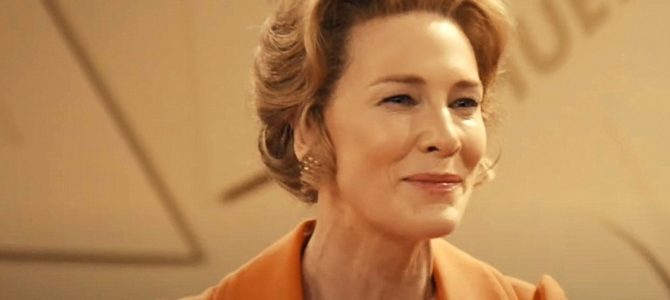
My grandmother was in a Daughters of the American Revolution Chapter with Phyllis Schlafly from 1965 to 1990. A few years before she died, I had the privilege to intern for Mrs. Schlafly. So, during quarantine, as we watched the FX series “Mrs. America” together, we became filled with growing frustration and disgust at seeing the woman we had known misrepresented and defamed.
What is most striking about “Mrs. America,” however, is how little it actually says about Schlafly. What the show truly reveals is the worldview of progressive Hollywood elites.
The show deserves credit for putting together a stunning cast. And it certainly does Schlafly a great honor to be portrayed by a world-renowned actress like Cate Blanchett. Sadly, even with an A-list ensemble, the show lacks the sort of inspiration that makes for brilliant storytelling. The absence of enthusiasm comes mostly from the fact that while the series attempts to depict a debate from both sides, the producers only understand one side of the argument. Ultimately, the show is left feeling self-congratulatory and hollow.
The men and women in charge of Hollywood programming fail or understand—or accept—how a successful woman like Schlafly could believe that a woman being in the home was either positive for society or fulfilling for an individual. They couldn’t conceive that a woman who held such “antiquated ideas” was anything other than ambitious, liberated, and power-hungry at heart.
Schlafly is depicted as an opportunist who wrecks all in her path to victory, including family and friends. It may make for a compelling “House of Cards” plotline, but when they portray of the champion of conservative women across America in the 1970s this way, it’s both absurd and false.
Unlike what many on the left and even characters in the show claim, Schlafly practiced what she preached. She took time away from her career to care for her family, returning to it when her children had grown. Within her organization, she made sure her female employees with young children at home were able to take the proper time off to invest in their families.
Flanked by her humble cadre of homemakers, Schlafly handed the feminist dream team defeat after defeat in one of the most extraordinary political David versus Goliath stories ever seen. It’s been four years since the world lost Phyllis Schlafly and frankly, the feminists are still losing to her.
The real Gloria Steinem, who was not consulted before production, was disgusted by the show and commented that “Mrs. America,” in fact, gave way too much credit to Schlafly, who in Steinem’s view, had almost nothing to do with the defeat of the ERA. Beyond the obvious post-defeat fantasy world Steinem has spun for herself, which many Goliaths do to explain seemingly inexplicable losses, Steinem hits on an appropriate critique of the show. It is bipolar.
On one hand, Schlafly is a selfish, ambitious, scrupulous leader who is often left speechless in the face of her feminist opponents, unable to answer their “ironclad facts” (which, it should be noted, were invented in the Hollywood writing room). Yet even as the show delights in dunking on Schlafly, it can’t rewrite history entirely. Like an ever-present lingering cloud, the fact that the ERA is defeated hangs over the story and stubbornly refuses to be brushed aside.
The self-congratulatory nature of the show seems especially discordant in a world where President Donald Trump won an election that was supposed to be Hillary Clinton’s coronation. Four years later, the Democratic Party is poised to nominate a famously moderate elderly white man from a crowd of female, minority, and homosexual candidates.
Once you realize the showrunners manipulation of visuals, it’s hard to ignore. The Schlafly’s live in a sterile gothic house with cold blue overhead light, while the feminists inhabit cozy Manhattan apartments full of cozy yellow lighting and rich, warm browns and maroons.
We are shown the world as the production team of “Mrs. America” sees it. The traditional home is indeed the “comfortable concentration camp” of Friedan’s “Feminist Mystique”—cold, selfish, and unforgiving. By contrast, the free love of New York City, unfettered by commitments or obligations, is compassionate and inviting even if it can get a little messy at times.
Phyllis and Fred Schlafly are frequently shown locked in competition as their ambitions clash, from Schlafly’s desire to renew her bid for Congress, to her attending law school against his wishes, and most dramatically, in a yelling match after a weak debate performance against Brenda and Marc Feigan-Fasteau.
For a moment lets disregard that fact that all accounts of Fred and Phyllis’s marriage from family and biographers portrays it as one of mutual love and support; forget for a moment that the actual recording of the debate with the Feigan-Fasteau’s proves that Schlafly more than held her own; disregard these inaccuracies and compare the austere image of a traditional home “Mrs. America” paints to the open, unstructured, variety of domestic arrangements portrayed by the feminist leaders.
Steinem is chic New York celebrity meets social activist. She’s depicted as kind, caring and deeply principled, while wrestling through tough pragmatic choices as any good leader must. She slips in and out of relationships without any messy breakup scenes and dances through her apartment following her dreams just as her black-market abortion doctor made her promise.
Brenda Feigan-Fasteau is shown engaging in an ongoing lesbian affair behind her husband’s back and then confessing it only to have Marc accept and support Brenda in her unfaithful liaisons. These moments are played to be beautiful and moving—visually and narratively—as characters display genuine selflessness.
The Phyllis Schlafly my grandmother knew for years had loving relationships with all her children. She cared for her husband in his old age and took pride in her grandchildren. In her later years when I worked for her, she took sincere interest in the lives of her staff and fellow homemakers. She was the exact opposite of the self-centered, sniping woman Cate Blanchett plays.
Schlafly remained brilliant ‘till the end. Even at age 90, she delighted in giving fiery radio interviews about misguided Obama Administration policies, laying her head down on her desk for cat naps in-between.
The attempt by “Mrs. America” to tarnish Phyllis Schlafly’s legacy in order to burnish those of the second wave feminists falls flat. Indeed, it only reminds the world that it was Schlafly’s movement and not the government-backed, financial juggernaut, Woman’s Liberation movement that won in the end.









